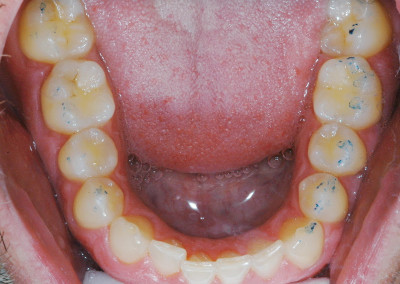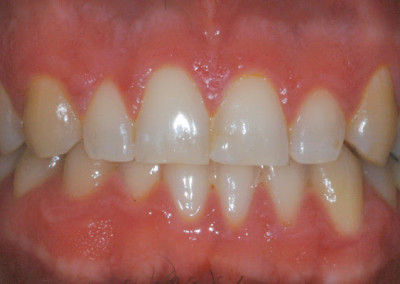As you can see, this young man has not spent much time in a dental chair. During his regular hygiene visit, gum pulls on the lower left from #18 to #21 were documented. The Comprehensive muscle and TMJ exam revealed no signs of dysfuction and the dentition itself show no significant signs either. None the less, the patient’s gum tissue is not holding in this one area. The clinical exam reveals that the maxillary arch is narrow, creating a wedge as the mandible engages the maxilla.
The intensity of the force itself is not an issue here, but it is the direction of the force that is causing a problem. The red line in the center shows how the direction of the force is wedged.
FUNCTION HEALTH
Although the teeth are nice and void of restorations, the bones do not fit correctly for a functional occlusion. In the anterior picture the lower canines, especially #22, are a full class III forward of #11. The upper arch is too narrow for the mandible and the lower teeth to fit, especially in the posterior left arch. Tooth #15 lingual cusp is the anterior control and when the left condyle is gently seated, all the force of the bite starts with the lingual cusp of #15 against the crowded and tilted #18 MB cusp. Whenever a larger mandible is wedged into a smaller maxilla ( like a class III mandible into a class I maxilla) then we have the standard problem of a “U” not fitting inside of a “V”. When this happens the patient must pick a side for dominate posterior force. In this case, the strong asymmetry is posterior left and two teeth control the entire occlusion. An equilibration and splint is required to prevent maladaptation of the left condyle, stabilize all the muscles and minimize the periodontal recession.
FUTURE CONSIDERATIONS…
Often, cases that do not require any restorative treatment are not considered for occlusion therapy. The force scan quickly identifies an occlusal interference that was destructive for an asymmetric envelope of function. The future will be the same as the past; keep the teeth, muscles, perio, and TM joints as healthy as possible.





